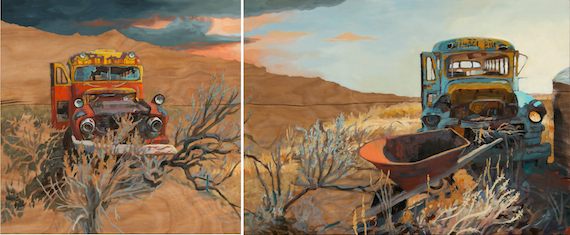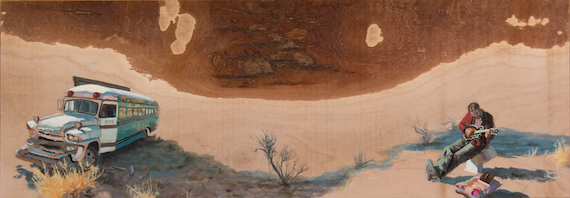I have written about Jazz-minh Moore's paintings before, and I'd like to add a little more here. Her second solo show at Claire Oliver Gallery is up until the end of July. She is still developing the broad themes she has been working on in the three or four years I've been avidly following her work: ruined places, their startling fertility, and their reclamation, all seen through a distinctly American lens. Within these themes, she does not repeat herself. In an earlier body of work, she depicted late childhood run wild among shattered wooden buildings. In the next, she depicted youth at play in a post-apocalyptic landscape burgeoning with plants. In the current show, "Middle of Nowhere," she locates a new cast of young adults in the vast wasteland of the southwestern desert.

Jazz-minh Moore, Arizona to Nevada, acrylic on panel, 2015, 10"x24"x2"
These paintings largely abandon the fantasy elements of her earlier work. They are attached more deeply to the present, and to the recent but irretrievable past, glimpsed in the wreckage of abandoned vehicles and weathered buildings. She herself went driving across the landscape she depicted, with no clear goal in mind but to receive what the land had to say. The experience of it she depicts in her work brings to mind the heartbreaking speech David Benioff wrote for James Brogan in the movie of 25th Hour:
"...Every man, woman, and child alive should see the desert one time before they die. Nothin' at all for miles around. Nothin' but sand and rocks and cactus and blue sky. Not a soul in sight. No sirens. No car alarms. Nobody honkin' atcha. No madmen cursin' or pissin' in the streets. You find the silence out there, you find the peace. You can find God..."

Jazz-minh Moore, Sunblind, acrylic on panel, 2015, 13"x59"x1"
Moore finds a radiance to the wasteland, and to the ruined things in it. She is driven to redeem wreckage, and she does it again here. It is a parched redemption, harder than her paradises of greenery. But as in the earlier instances, it offers such a heartening sense of reattachment, of the setting aside of vanities and alienations, of hopes for immortality, in exchange for a world of clean air and specific pleasures; a world which was always available, even if it was hidden for a while. One says, "I am an American, and I feel like my life is hollow, and I am choking on it. How am I to live?" and Moore's work takes your hand, as if you first met long ago, and says, "This way."

Jazz-minh Moore, Green Shade Mandolin, acrylic on panel, 2015, 9"x24"x1"
It is worth noting that the reclamation of ruin repeats itself in this body of work at the level of materials. Moore reclaims a ruined aesthetic. She has been painting on wood for years, but the wood she used for this show is, per the press release, "slabs of band-sawn wood from a local Oregon lumber mill, some with the bark still attached." If this doesn't bring anything to mind for you, let me clarify: it's the kind of stuff that kitschy furniture in your larger truck stop gift shops is made of. Irregular coffee tables or, cherry stained, clocks with raised metal hands and a couple migrating ducks painted on them. When I read what she was painting on these days, I winced.
And yet, it works spectacularly well. Like a Frank Lloyd Wright in miniature, she shapes her compositions to the topographies they rest on. Do you think she really came upon a sandy valley crested all around by scrubby hills? Perhaps she did - but it wasn't shaped like this:

Jazz-minh Moore, Nadia Spartanette, acrylic on birch panel, 2015, 11"x66"x2"
No, this is the artist awake to her materials and responding to the images they suggest to her. Or consider the title painting of the show, Middle of Nowhere, in which the wood grain, which comes across so poorly in the truck stop furniture, expands and expands until it resembles the lines of Earth's endlessly refolded crust, or pure perspective lines themselves, tracing out the broad expanse of the desert:

Jazz-minh Moore, Middle of Nowhere, acrylic on panel, 2015, 12"x34"x2"
So little is painted here, and so much implied. One participates extensively in completing the image, filling in the textures of sand, the distribution of pebbles and shrubs, the hazy quality of light in the air and its scintillation on the ground. Far from degrading these paintings, their medium makes them possible. Without it, they would be so far diminished as to be some other thing altogether. Moore reclaims this particular make of wood as an object of raw beauty, and once it is reclaimed, it becomes unclear how it could ever have been considered lost. The beauty was always present; it was we who were lost.
Jazz-minh Moore
Middle of Nowhere, until July 31, 2015
Claire Oliver Gallery, 512 West 26th St., NY, NY, 10001
Our 2024 Coverage Needs You
It's Another Trump-Biden Showdown — And We Need Your Help
The Future Of Democracy Is At Stake
Our 2024 Coverage Needs You
Your Loyalty Means The World To Us
As Americans head to the polls in 2024, the very future of our country is at stake. At HuffPost, we believe that a free press is critical to creating well-informed voters. That's why our journalism is free for everyone, even though other newsrooms retreat behind expensive paywalls.
Our journalists will continue to cover the twists and turns during this historic presidential election. With your help, we'll bring you hard-hitting investigations, well-researched analysis and timely takes you can't find elsewhere. Reporting in this current political climate is a responsibility we do not take lightly, and we thank you for your support.
Contribute as little as $2 to keep our news free for all.
Can't afford to donate? Support HuffPost by creating a free account and log in while you read.
The 2024 election is heating up, and women's rights, health care, voting rights, and the very future of democracy are all at stake. Donald Trump will face Joe Biden in the most consequential vote of our time. And HuffPost will be there, covering every twist and turn. America's future hangs in the balance. Would you consider contributing to support our journalism and keep it free for all during this critical season?
HuffPost believes news should be accessible to everyone, regardless of their ability to pay for it. We rely on readers like you to help fund our work. Any contribution you can make — even as little as $2 — goes directly toward supporting the impactful journalism that we will continue to produce this year. Thank you for being part of our story.
Can't afford to donate? Support HuffPost by creating a free account and log in while you read.
It's official: Donald Trump will face Joe Biden this fall in the presidential election. As we face the most consequential presidential election of our time, HuffPost is committed to bringing you up-to-date, accurate news about the 2024 race. While other outlets have retreated behind paywalls, you can trust our news will stay free.
But we can't do it without your help. Reader funding is one of the key ways we support our newsroom. Would you consider making a donation to help fund our news during this critical time? Your contributions are vital to supporting a free press.
Contribute as little as $2 to keep our journalism free and accessible to all.
Can't afford to donate? Support HuffPost by creating a free account and log in while you read.
As Americans head to the polls in 2024, the very future of our country is at stake. At HuffPost, we believe that a free press is critical to creating well-informed voters. That's why our journalism is free for everyone, even though other newsrooms retreat behind expensive paywalls.
Our journalists will continue to cover the twists and turns during this historic presidential election. With your help, we'll bring you hard-hitting investigations, well-researched analysis and timely takes you can't find elsewhere. Reporting in this current political climate is a responsibility we do not take lightly, and we thank you for your support.
Contribute as little as $2 to keep our news free for all.
Can't afford to donate? Support HuffPost by creating a free account and log in while you read.
Dear HuffPost Reader
Thank you for your past contribution to HuffPost. We are sincerely grateful for readers like you who help us ensure that we can keep our journalism free for everyone.
The stakes are high this year, and our 2024 coverage could use continued support. Would you consider becoming a regular HuffPost contributor?
Dear HuffPost Reader
Thank you for your past contribution to HuffPost. We are sincerely grateful for readers like you who help us ensure that we can keep our journalism free for everyone.
The stakes are high this year, and our 2024 coverage could use continued support. If circumstances have changed since you last contributed, we hope you'll consider contributing to HuffPost once more.
Already contributed? Log in to hide these messages.





